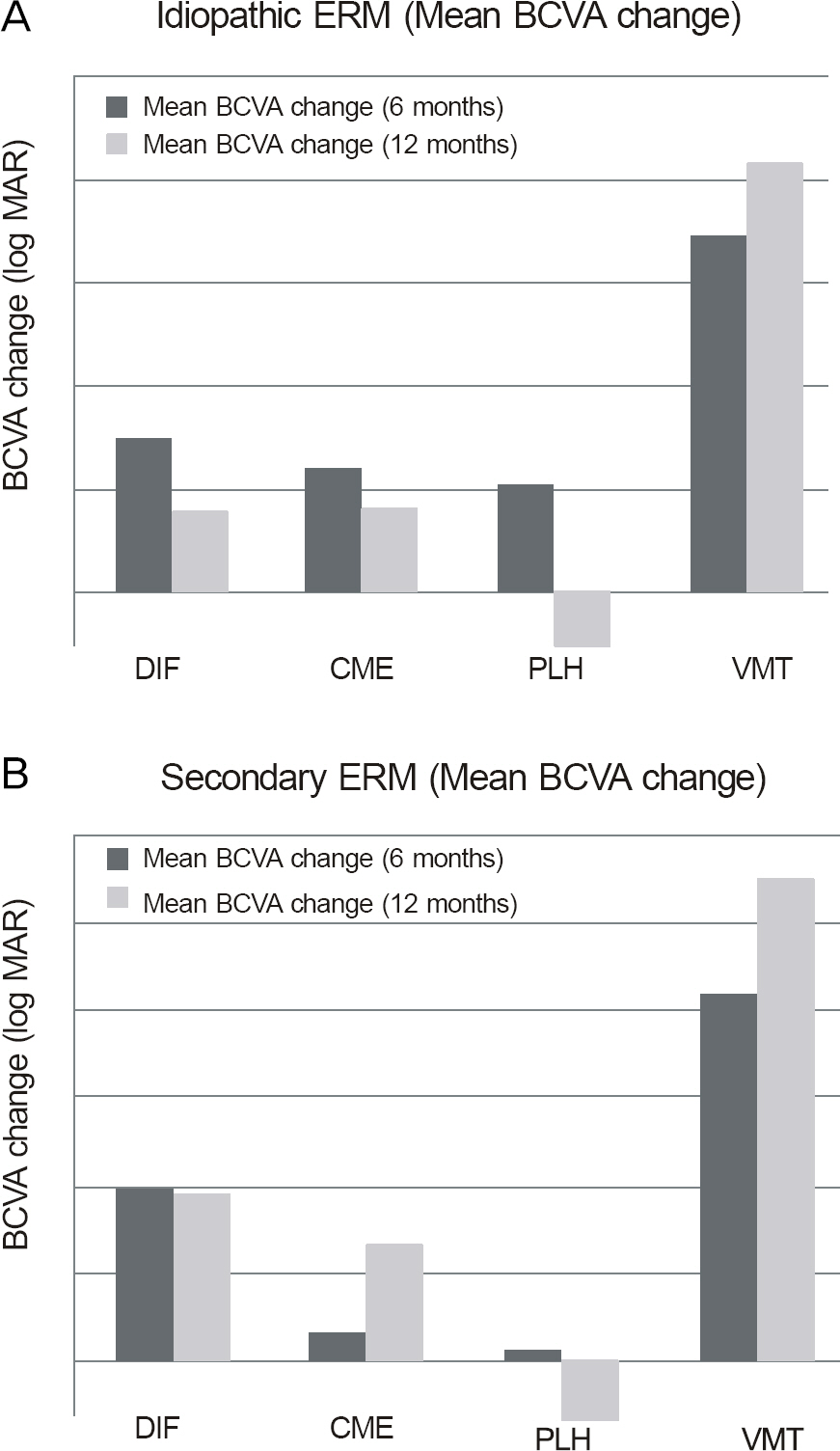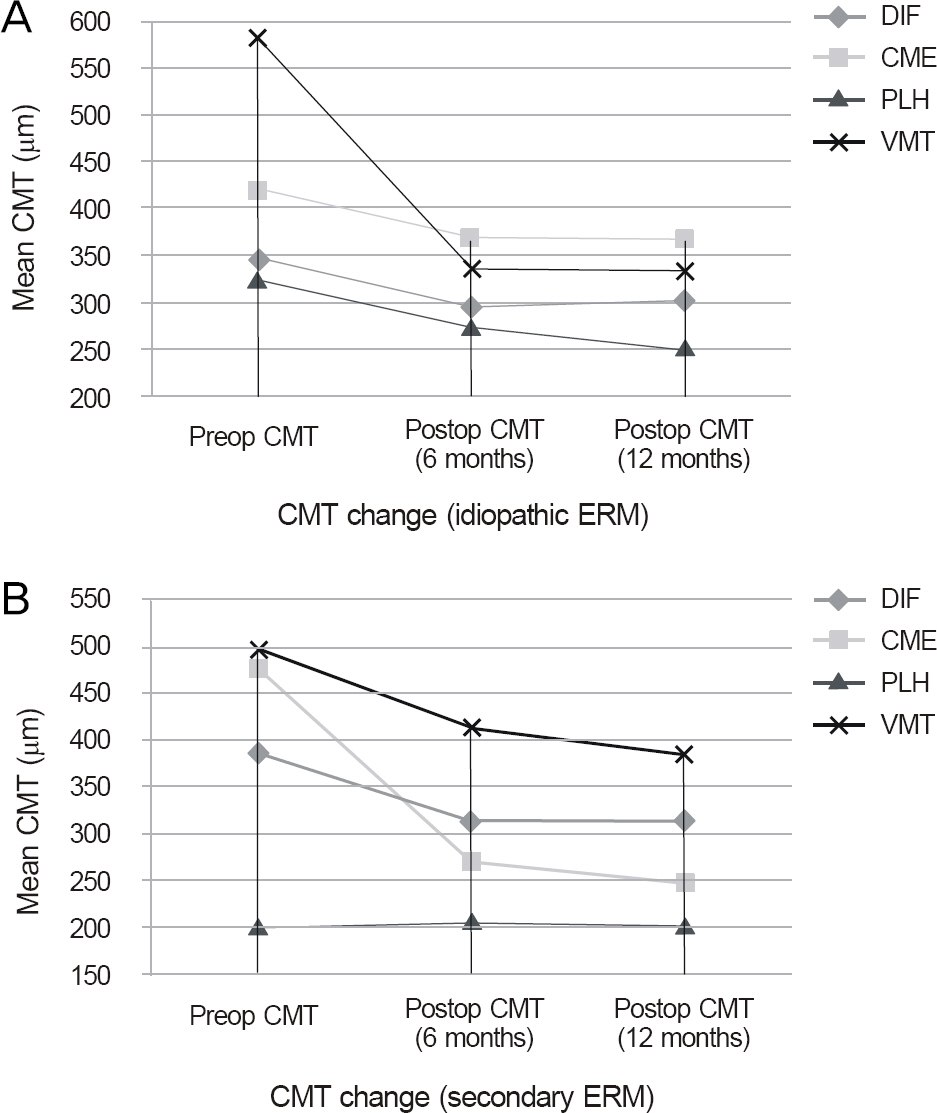J Korean Ophthalmol Soc.
2013 May;54(5):736-744. 10.3341/jkos.2013.54.5.736.
Surgical Outcome According to Morphology in Epiretinal Membrane Based on Optical Coherence Tomography (OCT)
- Affiliations
-
- 1Department of Ophthalmology, Maryknoll Medical Center, Busan, Korea. Pjm1438@hanmail.net
- 2Department of Ophthalmology, Haeundae Paik Hospital, Inje University College of Medicine, Busan, Korea.
- KMID: 2217039
- DOI: http://doi.org/10.3341/jkos.2013.54.5.736
Abstract
- PURPOSE
To determine the influence of morphologic classification based on optical coherence tomography (OCT) on epiretinal membrane (ERM) surgery outcomes.
METHODS
We retrospectively reviewed the medical records of 77 eyes with ERM treated by vitrectomy with ERM peeling. By using OCT, the preoperative ERM was classified into four types: diffuse (DIF), cystoids macular edema (CME), pseudolamellar hole (PLH), and vitreomacular traction (VMT). The postoperative changes of central macular thickness (CMT) and best-corrected visual acuity (BCVA) were compared.
RESULTS
Approximately six months postoperatively, the DIF type had the best BCVA for both idiopathic and secondary ERM, followed by the PLH, CME, and VMT types. On the other hand, regarding the mean BCVA improvement, the VMT type was the best, followed by the DIF, PLH, and CME types. When comparing the difference in BCVA improvement by each type, idiopathic ERM showed a clearer distinction when the inner segment/outer segment (IS/OS) junction was not disrupted.
CONCLUSIONS
BCVA improvement was significantly different depending on the morphologic classification of ERM by using OCT. Especially in cases of ERM with an intact IS/OS junction, the morphologic classification can help predict surgical outcomes.
MeSH Terms
Figure
Cited by 3 articles
-
Intraoperative Foveal Traction in Patients with Epiretinal Membrane
Hye Min Jeon, Sue Hey Chae, Chan Woo Bang, Min Soo Lee, Hee Seong Yoon
J Korean Ophthalmol Soc. 2018;59(8):738-744. doi: 10.3341/jkos.2018.59.8.738.Evaluation of Each Retinal Layer Thickness According to Preoperative OCT Patterns after Idiopathic ERM Removal
Sang Won Kim, Jae Hong Park, Dong Seob Ahn, Hee Seong Yoon
J Korean Ophthalmol Soc. 2014;55(12):1843-1852. doi: 10.3341/jkos.2014.55.12.1843.Surgical Outcomes in Epiretinal Membrane According to the Presence of Vitreomacular Traction Syndrome
Jong Won Moon, Ji Hye Jang, Young Wook Cho
J Korean Ophthalmol Soc. 2014;55(12):1834-1842. doi: 10.3341/jkos.2014.55.12.1834.
Reference
-
References
1. Margherio RR, Cox MS Jr, Trese MT, et al. Removal of epimacular membranes. Ophthalmology. 1985; 92:1075–83.
Article2. Michels RG. Vitrectomy for macular pucker. Ophthalmology. 1984; 91:1384–8.
Article3. Wise GN. Clinical features of idiopathic preretinal macular fibrosis. Schoenberg Lecture. Am J Ophthalmol. 1975; 79:349–7.
Article4. Hillenkamp J, Saikia P, Gora F, et al. Macular function and mor-phology after peeling of idiopathic epiretinal membrane with and without the assistance of indocyanine green. Br J Ophthalmol. 2005; 89:437–43.
Article5. Arndt C, Rebollo O, Séguinet S, et al. Quantification of meta-morphopsia in patients with epiretinal membranes before and after surgery. Graefes Arch Clin Exp Ophthalmol. 2007; 245:1123–9.
Article6. Wong JG, Sachdev N, Beaumont PE, et al. Visual outcomes fol-lowing vitrectomy and peeling of epiretinal membrane. Clin Experiment Ophthalmol. 2005; 33:373–8.
Article7. Hassenstein A, Scholz F, Richard G. [OCT in epiretinal gliosis]. Ophthalmologe. 2005; 102:127–32.8. Park SJ, Lee JH. Clinical feature of macular preretinal membrane and visual changes after vitrectomy. J Korean Ophthalmol Soc. 1994; 35:824–9.9. Rice TA, De Bustros S, Michels RG, et al. Prognostic factors in vi-trectomy for epiretinal membranes of the macula. Ophthalmology. 1986; 93:602–10.
Article10. Niwa T, Terasaki H, Kondo M, et al. Function and morphology of macula before and after removal of idiopathic epiretinal membrane. Invest Ophthalmol Vis Sci. 2003; 44:1652–6.
Article11. Wilkins JR, Puliafito CA, Hee MR, et al. Characterization of epiretinal membranes using optical coherence tomography. Ophthalmology. 1996; 103:2142–51.
Article12. Massin P, Allouch C, Hanouchine B, et al. Optical coherence to-mography of idiopathic macular epiretinal membranes before and after surgery. Am J Ophthalmol. 2000; 130:732–9.
Article13. Kim CH, Kim JI, Cho HY, Kang SW. Correlation between pre-operative OCT pattern and visual improvement in macular epi-retinal membrane. J Korean Ophthalmol Soc. 2007; 48:75–82.14. Suh MH, Seo JM, Park KH, Yu HG. Associations between macular findings by optical coherence tomography and visual outcomes af-ter epiretinal membrane removal. Am J Ophthalmol. 2009; 147:473–80.
Article15. Kinoshita T, Kovacs KD, Wagley S, Arroyo JG. Morphologic dif-ferences in epiretinal membranes on ocular coherence tomography as a predictive factor for surgical outcome. Retina. 2011; 31:1692–8.
Article16. Green WR, Kenyon KR, Michels RG, et al. Ultrastructure of epi-retinal membranes causing macular pucker after retinal reattach-ment surgery. Trans Ophthalmol Soc U K. 1979; 99:65–77.17. Smiddy WE, Michels RG, Glaser BM, et al. Vitrectomy for mac-ular traction caused by incomplete vitreous separation. Arch Ophthalmol. 1988; 106:624–8.
Article18. Smiddy WE, Maguire AM, Green WR, et al. Idiopathic epiretinal membranes. Ultrastructural characteristics and clinic pathologic correlation. Ophthalmology. 1989; 96:811–20; discussion 821.
Article19. Gastaud P, Bétis F, Rouhette H, Hofman P. Ultrastructural findings of epimacular membrane and detached posterior hyaloid in vitre-omacular traction syndrome. J Fr Ophthalmol. 2000; 23:587–93.20. Puliafito CA, Hee MR, Lin CP, et al. Imaging of macular diseases with optical coherence tomography. Ophthalmology. 1995; 102:217–29.
Article21. Koizumi H, Spaide RF, Fisher YL, et al. Three-dimensional evalu-ation of vitreomacular traction and epiretinal membrane using spectral-domain optical coherence tomography. Am J Ophthalmol. 2008; 145:509–17.
Article22. Mori K, Gehlbach PL, Sano A, et al. Comparison of epiretinal membranes of differing pathogenesis using optical coherence tomography. Retina. 2004; 24:57–62.
Article23. Dugas B, Ouled-Moussa R, Lafontaine P, et al. Idiopathic epi-retinal macular membrane and cataract extraction: combined ver-sus consecutive surgery. Am J Ophthalmol. 2010; 149:302–6.
Article24. Muselier A, Dugas B, Burelle X, et al. Macular hole surgery and cataract extraction: combined vs consecutive surgery. Am J Ophthalmol. 2010; 150:387–91.
Article
- Full Text Links
- Actions
-
Cited
- CITED
-
- Close
- Share
- Similar articles
-
- Choroidal Thickness Changes Following Vitrectomy in Epiretinal Membrane Based on the Optical Coherence Tomography Pattern
- The Evaluation of Prognostic Factors after Vitrectomy for Lamellar Macular Hole Using Optical Coherence Tomography
- Visual and Surgical Outcomes of Lamellar Macular Hole
- Availability of Optical Coherence Tomography in Diagnosis and Classification of Choroidal Neovascularization
- Changes in Macular Thickness after Cataract Surgery According to Optical Coherence Tomography




